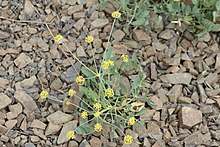Lomatium nudicaule
| Lomatium nudicaule | |
|---|---|

| |
| Scientific classification | |
| Kingdom: | Plantae |
| Clade: | Tracheophytes |
| Clade: | Angiosperms |
| Clade: | Eudicots |
| Clade: | Asterids |
| Order: | Apiales |
| Family: | Apiaceae |
| Genus: | Lomatium |
| Species: | L. nudicaule
|
| Binomial name | |
| Lomatium nudicaule | |
Lomatium nudicaule is a species of flowering plant in the carrot family known by the common names pestle lomatium,[1]: 110 [2] barestem biscuitroot, Indian celery and Indian consumption plant. It is native to western North America from British Columbia to California to Utah, where it is known from several habitat types, including forest and woodland. It is a perennial herb growing up to about 70 centimetres (28 in) tall from a thick taproot. It generally lacks a stem, the inflorescence and leaves emerging from ground level. The leaves are made up of many dull green, waxy lance-shaped leaflets each up to 9 cm long. The inflorescence is borne on a stout, leafless[3] peduncle widening at the top where it blooms in an umbel of yellow or purplish flowers.

Uses
This plant is a traditional source of food for many
References
- ISBN 0-7627-3805-7
- ^ Barestem Biscuitroot, USDA
- OCLC 25708726.
- ^ "Ethnobotany". Archived from the original on 2012-02-25. Retrieved 2009-08-21.
- ^ Turner, Nancy J. The Earth's Blanket. Douglas & McIntyre, 2005, p.48-50
External links
- Calflora Database: Lomatium nudicaule (Barestem biscuitroot, Pestle lomatium, Pestle parsnip)
- Jepson Manual eFlora treatment of Lomatium nudicaule
- USDA Plants Profile for Lomatium nudicaule (barestem biscuitroot)
- UC CalPhotos gallery
n
